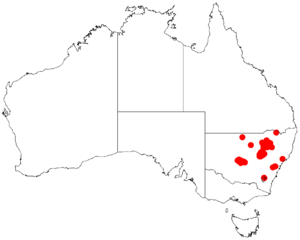Golden-top wattle facts for kids
Acacia mariae, often called golden-top wattle or crowned wattle, is a type of wattle plant. It grows naturally in the central parts of New South Wales, Australia. This plant is known for its bright yellow flowers and unique leaf-like structures.
Quick facts for kids Golden-top wattle |
|
|---|---|
| Scientific classification | |
| Genus: |
Acacia
|
| Species: |
mariae
|
 |
|
| Occurrence data from AVH | |
Contents
What Does Golden-Top Wattle Look Like?
This wattle usually grows as a shrub. It can be anywhere from 1 to 2 metres (about 3 to 6 feet) tall. It might grow straight up or spread out. The bark is smooth and grey. Its branches are often angled and covered in fine hairs.
Special Leaves and Flowers
Like many wattles, Acacia mariae doesn't have true leaves. Instead, it has special flattened stems called phyllodes. These phyllodes look like leaves and do the same job. They are evergreen, meaning they stay green all year. They are narrow and can be straight or slightly curved. These phyllodes are covered in silvery-grey hairs. They are quite small, about 0.4 to 1.3 centimetres long and 1 to 2 millimetres wide.
The golden-top wattle blooms between July and October. It produces bright yellow, round flower-heads. Each flower-head is about 5 to 7 millimetres wide. They contain 22 to 38 tiny flowers. These flower-heads grow alone where the phyllodes meet the stem.
Seed Pods
After the flowers, the plant grows flat, straight seed pods. These pods are about 3 to 6 centimetres long and 8 to 11 millimetres wide. They have a thin, leathery feel.
How Golden-Top Wattle Got Its Name
The plant was first officially described in 2006. A botanist named Leslie Pedley gave it its scientific name. The second part of its name, mariae, honours Mary Tindale. She was a botanist who worked at the National Herbarium of New South Wales. Sometimes, people confuse Acacia mariae with another wattle called Acacia conferta.
Where Golden-Top Wattle Grows
You can find Acacia mariae in central New South Wales, Australia. It grows on the eastern side of the Great Dividing Range. Its range stretches from places like Hillston and Katoomba in the south. It goes up to the Hunter Valley in the east.
It often grows on slopes and is common in the Pilliga Scrub. This wattle prefers sandy soils. It is usually found in dry woodlands and areas with mallee trees.

